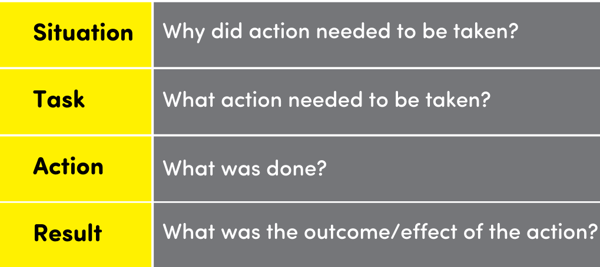You are in a job interview and things are going really well. You have established a connection with the interviewer and were even able to inject some humor into the conversation. Then, just when you think it is smooth sailing, the interviewer asks you a behavioral question that sends you into a frenzy. Sound familiar?
Behavioral questions are part of Behavioral Based Interviews (BBI) and call upon you to provide real-life examples of how you handled a situation in the past. Interviewers use this type of questioning to understand how you have reacted and behaved in past circumstances as an indicator of how you will behave in future situations. The insights gained help them determine if you are a good fit for their company, team and the role you are interviewing for. Behavioral questions are generally easy to recognize as they are open-ended questions meant to elicit a story. Some common phrasing includes:
- Tell me about a time when you…
- How did you handle a situation when…
- Can you share an example of when you…
- Describe an occurrence when…
The initial question is then followed-up with probing language like:
- Then what happened…
- Can you explain that…
- Were there any surprises…
- How did you manage that…
- What did you learn from this…
The STAR approach:
Being able to provide real-life examples when it comes to behavioral questions is necessary for a successful interview. You want to be authentic and comfortable describing a situation that actually happened to you. But, when it comes to sharing the details, it is important to do it in a compelling and easy to understand way without rambling or giving unnecessary details. This is exactly where STAR approach helps.
STAR stands for:

Interviewers trained in the STAR method will set the stage and probe and prompt for details, but as a candidate you can help yourself by knowing this model in advance. Being able to provide real-life examples of how you assessed a situation, determined what needed to be done, what you did and then sharing the outcome of your actions, will result in a more successful interview experience. You want to be authentic and comfortable describing a situation that you experienced, without rambling or sharing unnecessary details.
Situation: In this stage, lay out a brief background of the circumstances that required an action. Make sure to only include details that are relevant to your story.
Task: Describe what you identified as required actions/next steps. What was your responsibility in the situation?
Action: What did you actually do? (Not always the same as what you thought had to be done) What actions/steps did you take to influence the desired outcome of a situation?
Result: Talk about the outcome of your action or how your action impacted the situation. Where appropriate provide a numerical measurement of your success such as “My efforts helped to increase the productivity by 3% y/y” rather than just saying “My efforts helped to increase my team’s productivity.”
Responding to questions by addressing these 4 components helps the interviewer gauge if a potential candidate will perform well in the role and fit within the existing team and organizational culture.
Some common topics or themes that BBI questions address include:
- Communication skills
- Conflict resolution skills
- Team interactions/dynamics
- Response to constructive feedback
- Ability to manage a project/ program/product
Steps to prepare STAR responses:
Feeling nervous when answering behavioral questions is more common than you may think. Even the most qualified, experienced and confident professionals are likely to admit to some level of nervousness and difficulty when answering such questions. An important factor to keep in mind to help manage this anxiety is that there is not just one right answer, as your responses are based on your own experiences. It is, in fact, an opportunity for you share a compelling story to highlight what you bring to the organization and role.
1) Listen to the question carefully
2) Think of a suitable example. It is acceptable to create some thinking time for yourself by saying, “Let me think about the best example/most recent example to share with you for a minute.”
3) Layout the situation with essential details
4) Highlight your involvement in managing/changing the situation; specifically mention your identified task(s)
5) Share your action plan; step-by-step
6) Finally, share the outcome
Practice
Gaining confidence and competence in responding well to BBI interview formats comes down to practice. Anticipate key behaviors that are likely to be explored for the role you are interviewing for and identify relevant past experiences. Write out your responses using the STAR method and practice in front of a mirror or ask a friend to help you out with a mock interview. You want to prepare to build confidence, but not rehearse to the point of losing authenticity.
Although the STAR interview answer technique may seem daunting when you are starting, it will help you to construct even the most complex situations in an easy-to-understand way so that you are able to give a confident and structured answer in your behavioral interview. In most cases, you should be able to layout your answer in under a minute.
Resource: Wondering what kind of behavioral questions to expect in your next interview? Download our list of
15 commonly asked behavioral questions.
Here’s an example using the STAR approach to answer a question in BBI:
.png?width=1414&name=Behavioral%20questions%20(1).png)


